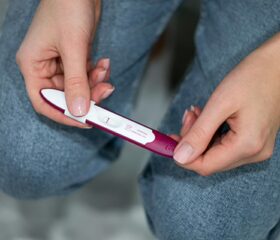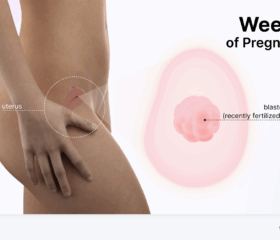PMS vs. Pregnancy Symptoms: How to Tell the Difference
If you suspect that you’re pregnant, it's easy to overanalyze every bodily sensation, especially considering that many symptoms of early pregnancy are similar to those of PMS.

If you’re not sure whether you’re PMSing or pregnant, you’re in the right place. We’ll explain why these two conditions can feel so similar, how you can (potentially) tell the difference between them, and when you can take a pregnancy test to confirm for sure.
How are PMS and pregnancy symptoms different?
Despite the overlap, there are a few subtle differences between PMS and early pregnancy symptoms that you may be able to spot, especially if you’ve been keeping track of what’s normal for you in your journal or a period tracker app.
Cramping
There are slight differences in the timing and sensation between pregnancy and PMS cramping:
- When it starts: Menstrual cramping tends to start around a day or two before your period comes, whereas you can get uterine cramping from pregnancy as early as 1 week before your period is due. 1
- How it feels: Period cramps can be intense, causing a throbbing pain that may radiate down to your lower back and legs. Pregnancy cramps, on the other hand, are typically lighter—you might feel them as a pulling or tingling sensation. 1
Breast changes
If you’re pregnant as opposed to dealing with PMS, your breast tenderness will differ in:
- When it starts: Breast tenderness is one of the earliest signs of pregnancy, and you may experience it 1–2 weeks after conception. 5 If your tenderness is the result of PMS, it will probably strike later, just before your period is due.
- How it feels: You might find that your soreness is a little stronger than “normal” period cramps. 6
- What it’s accompanied by: If you’re pregnant, the aching in your breasts may be accompanied by more sensitive nipples, which PMS doesn’t usually cause. Moreover, the small bumps around your nipples (the Montgomery glands) may become more pronounced, resembling goosebumps. These glands produce oils to prepare your nipples for breastfeeding. 7
Implantation bleeding
Implantation bleeding happens as a result of a fertilized egg implanting in the lining of your uterus. While you might mistake it for your period, implantation bleeding differs in its: 8
- Timing: Implantation occurs earlier than when you’d normally get your period (anywhere from a few days to a week before). If the bleeding comes ahead of schedule, it could mean you’re pregnant.
- Flow: Implantation bleeding is usually much lighter than a “regular” period.
- Duration: It can last from a few hours to a couple of days. Bleeding that lasts longer than that is probably your period.
- Color: Implantation bleeding is usually pale to medium pink or light brown (sometimes appearing as pink-tinged mucus), in contrast to the darker red color of menstrual blood.
Note that not all pregnant women experience implantation bleeding. If you don’t have it, that doesn’t mean you’re not pregnant.
Fatigue
Fatigue (tiredness) is a symptom of both PMS and early pregnancy. Telling the two causes apart can be tricky; pregnancy-related fatigue may last longer and be more intense, but that isn’t always the case, so by itself, being unusually tired doesn’t necessarily mean you’re pregnant.
Cravings and aversions
While food cravings can be caused by both PMS and pregnancy, their precise nature often differs:
- PMS cravings: With PMS, it’s more common for your cravings to revolve around comfort foods like chocolate or carbs. You’re less likely to have cravings for foods you weren’t previously interested in. Strong aversions to food aren’t common with PMS.
- Pregnancy cravings: In early pregnancy, appetite changes tend to be more specific and often unusual (think pickles and ice cream). Sometimes, you may even develop strong aversions during pregnancy to foods or smells you previously enjoyed. 9
Relatedly, many women report that their sense of smell becomes heightened during early pregnancy, making them more aware of (and sometimes even repulsed by) certain scents. This isn’t usually a symptom of PMS, so it points to pregnancy.
Tell your doctor if you crave non-food items
In rare cases, pregnant women may crave non-food items, such as soil, clay, or ice chips. This condition is known as pica. If you have any unusual cravings (even for ice), bring them up with your doctor right away, as pregnancy-related pica often comes about due to nutritional deficiencies (e.g., a lack of zinc or iron).
Why a pregnancy test is the only way to know if you’re pregnant
While paying attention to these subtle differences can give you clues, bodies can be unpredictable. The only truly reliable way to figure out if your symptoms are due to pregnancy or PMS is by taking a pregnancy test.
When can you take a pregnancy test?
Home pregnancy test strips and digital tests look for hCG, which your body produces after implantation. They’re up to 99% accurate (based on laboratory testing), provided you take them correctly and at the right time.
For the most accurate results, wait until the day your next period is due. This means that if your symptoms set in a bit earlier than that (around when you usually start PMSing), you’ll have to be patient. If you test too early, you probably won’t have enough hCG in your system to get a positive result, and will end up with a false negative. 10
If you have irregular cycles, wait at least 3 weeks after you had sex to test. 11
How to take a pregnancy test correctly
When you take a pregnancy test, always follow the instructions carefully, and try to test early in the morning, when hCG tends to be most concentrated in your urine. 12
Follow up any positive pregnancy test with a call to your doctor. They’ll confirm your pregnancy with a blood test and get you started on your all-important prenatal care.
Can you find out earlier if you’re pregnant?
While some tests claim that you can use them a few days before your expected period, you’re more likely to get inaccurate results. If you get a negative result but still suspect your symptoms are caused by pregnancy and not PMS, test again when your period is due.
If you’re desperate to find out for sure sooner rather than later, you can get your doctor to perform a blood test, which can detect pregnancy as early as 6–8 days after conception.
This is also a good option if you get a negative pregnancy test result but your period is late by more than a week or two. A blood test can rule out other potential causes, like hormonal imbalances or a chemical pregnancy (an early form of miscarriage). 13
Final thoughts
PMS and early pregnancy symptoms can be similar, but the subtle differences between them may be able to give you more clarity.
However, every woman’s body is different, so the only way to know for sure whether you’re expecting is by taking a pregnancy test around the time you expect your next period.
Article Sources
- Hackensack Meridian Health. "Cramp Confusion: Early Pregnancy or Period? Understanding the Difference" Retrieved May 29, 2025.
- American College of Obstetricians and Gynecologists. "Premenstual Syndrome (PMS)" Retrieved May 29, 2025.
- Cleveland Clinic. "Luteal Phase" Retrieved May 29, 2025.
- The University of Chicago Medical Center. "Tips for managing pregnancy symptoms by trimester" Retrieved May 29, 2025.
- MedicalNewsToday. "How to tell the difference between PMS and pregnancy symptoms" Retrieved May 29, 2025.
- Cleveland Clinic. "Am I Pregnant?" Retrieved May 29, 2025.
- Breast Cancer Now. "Breast changes during or after pregnancy" Retrieved May 29, 2025.
- Cleveland Clinic. "Implantation Bleeding" Retrieved May 29, 2025.
- Tommy’s. "Pregnancy cravings and food aversions" Retrieved May 29, 2025.
- The University of Texas Southwestern Medical Center. "How early can home pregnancy tests show positive results?" Retrieved May 29, 2025.
- Planned Parenthood. "Pregnancy Tests" Retrieved May 29, 2025.
- NewYork-Presbyterian Hospital. "Pregnancy Testing" Retrieved May 29, 2025.
- Cleveland Clinic. "Chemical Pregnancy" Retrieved May 29, 2025.







